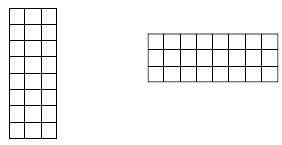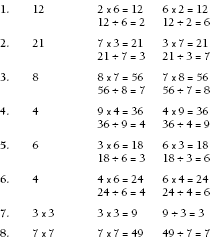This is a level 3 number activity from the Figure It Out series. It relates to Stage 6 of the Number Framework.
A PDF of the student activity is included.
Click on the image to enlarge it. Click again to close. Download PDF (181 KB)
know multiplication facts
Activities similar to those suggested for page 7 can be introduced. Shading odd and even answers on a copy of the multiplication array produces a pattern of a few odd numbers surrounded by even numbers. Students should be encouraged to explain why this occurs. This may lead to general rules about the product of numbers:
O x O = O
O x E = E
E x O = E
E x E = E
where O is any odd number and E is any even number.
Students might look for factors of a given product, say 24 or 18, write the equations, and look for
patterns:
These equations might be modelled with square tiles to investigate why the patterns occur. For example, 3 x 8 and 8 x 3 can be seen as rotations of each other:
3 x 8 can be mapped onto 4 x 6.
Students might also investigate the numbers along the diagonals of the table, for example: 4, 9, 16, 25, 36, … (square numbers)
2 x 2 squares of numbers can also be looked at for patterns. For example:
Students may need calculators to find the products. Note that the products of the numbers on each diagonal are equal, and the sums of these numbers have a difference of one.
Answers to Activity
Activity One
Note: Each family of facts contains either two or four equations.
Activity Two
1. 8 equations (2 x 6 = 12, 6 x 2 = 12, 12 ÷ 6 = 2, 12 ÷ 2 = 6, 4 x 3 = 12, 3 x 4 = 12, 12 ÷ 4 = 3, 12 ÷ 3 = 4)
2. 4 equations (6 x 7 = 42, 7 x 6 = 42, 42 ÷ 6 = 7, 42 ÷ 7 = 6)
3. 8 equations (6 x 4 = 24, 4 x 6 = 24, 24 ÷ 6 = 4, 24 ÷ 4 = 6, 8 x 3 = 24, 3 x 8 = 24, 24 ÷ 8 = 3, 24 ÷ 3 = 8) Other equations for 24 not shown on this array:
2 x 12 = 24, 12 x 2 = 24, 24 ÷ 2 = 12, 24 ÷ 12 = 2
4. 8 equations (6 x 3 = 18, 3 x 6 = 18, 18 ÷ 6 = 3, 18 ÷ 3 = 6, 2 x 9 = 18, 9 x 2 = 18, 18 ÷ 2 = 9, 18 ÷ 9 = 2)
5. 2 equations (9 x 9 = 81, 81 ÷ 9 = 9)
6. 6 equations (4 x 4 = 16, 16 ÷ 4 = 4, 8 x 2 = 16, 2 x 8 = 16, 16 ÷ 2 = 8, 16 ÷ 8 = 2)
7. 2 equations (5 x 5 = 25, 25 ÷ 5 = 5)
8. 4 equations (9 x 3 = 27, 3 x 9 = 27, 27 ÷ 9 = 3, 27 ÷ 3 = 9)
Note: The full family of facts is not required for this activity but is provided here for reference.





